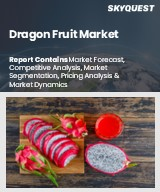
세계의 용과 시장 규모는 2023년에 248억 달러로 평가되며, 2024년 259억 2,000만 달러에서 2032년에는 368억 6,000만 달러로 성장하며, 예측 기간(2025-2032년)의 CAGR은 4.5%로 성장할 전망입니다.
세계 용과 시장은 건강과 웰빙에 대한 소비자의 관심 증가로 인해 크게 성장하고 있으며, 영양이 풍부한 슈퍼푸드로서 용과에 대한 인식이 높아짐에 따라 용과 시장이 크게 성장하고 있습니다. 비타민, 미네랄, 항산화 물질이 풍부하게 함유되어 있으며, 기능성 식품 및 천연 소재로서의 매력을 높이고 있습니다. 과일의 독특한 모양과 맛은 생식부터 음료와 디저트에 이르기까지 다양한 요리에 활용될 수 있습니다. 또한 화장품 및 의약품에 대한 응용 가능성도 있으며, 시장 수요를 증가시킬 가능성이 높습니다. 그러나 높은 부패성, 재배를 위한 기후적 제약, 병해충에 대한 취약성 등의 과제가 큰 걸림돌로 작용하여 공급 안정성과 생산 비용에 잠재적인 영향을 미치는 동시에 전체 시장공급망과 접근성에 영향을 미치고 있습니다.
Global Dragon Fruit Market size was valued at USD 24.8 billion in 2023 and is poised to grow from USD 25.92 billion in 2024 to USD 36.86 billion by 2032, growing at a CAGR of 4.5% during the forecast period (2025-2032).
The global dragon fruit market is experiencing significant growth driven by a rising consumer focus on health and wellness, bolstered by dragon fruit's status as a nutrient-rich superfood. Its rich blend of vitamins, minerals, and antioxidants enhances its appeal as a functional food and natural ingredient. The fruit's unique appearance and flavor enable diverse culinary uses, from fresh consumption to incorporation in beverages and desserts. Furthermore, its potential applications in cosmetics and pharmaceuticals are likely to enhance market demand. However, challenges such as high perishability, climatic limitations for cultivation, and vulnerability to pests and diseases pose significant hurdles, potentially affecting supply stability and production costs while impacting the overall market supply chain and accessibility.
Top-down and bottom-up approaches were used to estimate and validate the size of the Global Dragon Fruit market and to estimate the size of various other dependent submarkets. The research methodology used to estimate the market size includes the following details: The key players in the market were identified through secondary research, and their market shares in the respective regions were determined through primary and secondary research. This entire procedure includes the study of the annual and financial reports of the top market players and extensive interviews for key insights from industry leaders such as CEOs, VPs, directors, and marketing executives. All percentage shares split, and breakdowns were determined using secondary sources and verified through Primary sources. All possible parameters that affect the markets covered in this research study have been accounted for, viewed in extensive detail, verified through primary research, and analyzed to get the final quantitative and qualitative data.
Global Dragon Fruit Market Segments Analysis
Global Dragon Fruit Market is segmented by Form, Nature, End Use, Distribution Channel and region. Based on Form, the market is segmented into Powder and Puree. Based on Nature, the market is segmented into Organic and Conventional. Based on End Use, the market is segmented into Food and Beverages, Foodservice, Retail/Household and Others. Based on Distribution Channel, the market is segmented into Business to Business and Business to Consumer. Based on region, the market is segmented into North America, Europe, Asia Pacific, Latin America and Middle East & Africa.
Driver of the Global Dragon Fruit Market
The growing global focus on health and wellness significantly propels the dragon fruit market. As consumers become more health-conscious, there is a heightened demand for foods rich in nutrients with proven health advantages. Dragon fruit stands out in this regard, being packed with antioxidants, vitamins especially vitamin C minerals, and fiber, making it a compelling choice. Its recognition as a "superfood" aligns perfectly with the increasing interest in functional foods, resulting in greater consumption across diverse demographics. Notably, this trend is especially pronounced in developed markets, where individuals are increasingly opting for healthier dietary choices.
Restraints in the Global Dragon Fruit Market
A key challenge faced by the global dragon fruit market lies in its perishable nature, which contributes to a limited shelf life. This intrinsic characteristic complicates transportation, storage, and distribution, especially in international trade. Maintaining appropriate temperature and humidity levels throughout the supply chain is crucial to prevent spoilage, resulting in increased logistical complexity and associated costs. Such vulnerabilities heighten the risks of post-harvest losses, thereby limiting profitability and making it difficult for the market to consistently satisfy demand, particularly in regions that do not produce dragon fruit. This limitation poses a significant constraint on market growth and stability.
Market Trends of the Global Dragon Fruit Market
The global dragon fruit market is undergoing a significant transformation, driven by the rising demand for value-added products. As consumers increasingly seek convenient and innovative dietary options, the popularity of processed forms of dragon fruit such as powders, purees, juices, and snacks-has surged. This trend is fueled by busy lifestyles, with health-conscious individuals looking for exotic ingredients that offer nutritional benefits. Additionally, the extended shelf life of these processed products not only mitigates post-harvest losses but also enables broader distribution in diverse markets. Consequently, the dragon fruit sector is evolving, catering to modern consumer preferences while enhancing market reach.